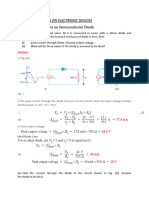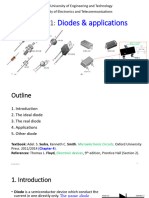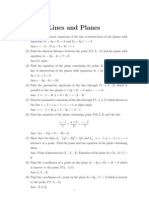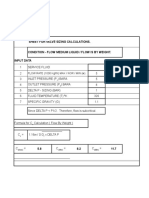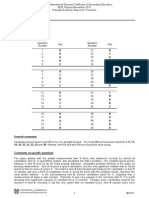EE-203 Diode Circuits Analysis Problem 1: Plot the load line and find the Q-point for the
diode circuit in Figure 1 if V = 5 V and R = 10 k. Use the i-v characteristic in Figure 2.
Figure 1
Figure 2
Solution:
5 = 104 I D + VD | VD = 0 I D = 0.500mA | I D = 0 VD = 5V Forward biased - VD = 0.5V ID = 4.5V = 0.450 mA 104
�EE-203 Diode Circuits Analysis
iD
2 mA
1 mA Q-point vD 1 2 3 4 5
Problem 2:
Find the Q-point for the circuit in Figure 3 using the ideal diode model and constant voltage drop model with Von=0.6V.
Figure 3
Solution :
Ideal diode model: ID = 1V/10k = 100 A; (100 A, 0 V) Constant voltage drop model: ID = (1-0.6)V/10k = 40.0 A; (40.0 A, 0.6 V)
�EE-203 Diode Circuits Analysis Problem 3:
Find the Q-point for the diode in Figure 4 using (a) the ideal diode model and (b) the constant voltage drop model with Von = 0.6 V. (c) Discuss the results. Which answer do you feel is most correct?
Figure 4
Solution :
Using Thvenin equivalent circuits yields and then combining the sources
1.2 k 1.6 V +
I V +
1k + 2V
I V +
2.2 k + 0.4 V
(a) Ideal diode model: The 0.4 V source appears to be forward biasing the diode so we will assume it is "on". Substituting the ideal diode model for the forward region 0.4V = 0.182 mA . This current is greater than zero, which is consistent yields I = 2.2k with the diode being "on". Thus the Q-pt is (0 V, +0.182 mA).
�EE-203 Diode Circuits Analysis
I V + 2.2 k + 0.4 V
Ideal Diode:
V - + I 0.6 V 2.2 k + 0.4 V
on
CVD:
(b) CVD model: The 0.4 V source appears to be forward biasing the diode so we will assume it is "on". Substituting the CVD model with Von = 0.6 V yields 0.4V 0.6V = 90.9 A . This current is negative which is not consistent with I= 2.2k the assumption that the diode is "on". Thus the diode must be off. The resulting Q-pt is: (0.4 V, 0 mA).
V + I=0
2.2 k + 0.4 V
(c) The second estimate is more realistic. 0.4 V is not sufficient to forward bias the diode into significant conduction. For example, let us assume that IS = 10-15 A and assume that the full 0.4 V appears across the diode. Then
0.4V iD = 1015 A exp 1 = 8.89 nA , a very small current. 0.025V
�EE-203 Diode Circuits Analysis Problem 4:
(a) Find I and V in the four circuits in Figure 5 using the ideal diode model. (b) Repeat using the constant voltage drop model with Von = 0.7 V.
Figure 5
(a)
5 ( 5) = 0.500 mA 20k (b) Diode is reverse biased: I =0 | V=7 20k ( I ) = 7 V | VD = 10 V (a ) Diode is forward biased:V = 5+0= 5 V | I= (c) Diode is forward biased:V =3 0=3 V | I=
3 ( 7) = 0.500 mA 20k (d ) Diode is reverse biased: I =0 | V= 5 + 20k ( I ) = 5 V | VD = 10 V (b)
5 ( 4.3) = 0.465 mA 20k (b) Diode is reverse biased: I =0 | V=7 20k ( I ) = 7 V | VD = 10 V (a ) Diode is forward biased:V = 5+0.7= 4.3 V | I= 2.3 ( 7) = 0.465 mA 20k (d ) Diode is reverse biased: I =0 | V= 5 + 20k ( I ) = 5 V | VD = 10 V (c) Diode is forward biased:V =3 0.7=2.3 V | I=
�EE-203 Diode Circuits Analysis Problem 5:
(a) Find I and V in the four circuits in Figure 5 using the ideal diode model if the resistor values are changed to 100 k. (b) Repeat using the constant voltage drop model with Von = 0.6 V.
Solution :
(a) 5 ( 5) = 100 A 100k (b) Diode is reverse biased: I =0 A | V=7 100k ( I ) = 7 V | VD = 10 V (a ) Diode is forward biased:V = 5+0= 5 V | I= (c) Diode is forward biased:V =3 0=3 V | I=
3 ( 7 ) = 100 A 100k (d ) Diode is reverse biased: I =0 A | V= 5 + 100k ( I ) = 5 V | VD = 10 V (b) 5 ( 4.4) = 94.0 A 100k (b) Diode is reverse biased: I =0 | V=7 100k ( I ) = 7 V | VD = 10 V (a ) Diode is forward biased:V = 5+0.6= 4.4 V | I= 2.4 ( 7) = 94.0 A 100k (d ) Diode is reverse biased: I =0 | V= 5 + 20k ( I ) = 5 V | VD = 10 V (c) Diode is forward biased:V =3 0.6=2.4 V | I=
�EE-203 Diode Circuits Analysis Problem 6:
Find the Q-points for the diodes in the circuits in Figure 6 using the ideal diode model.
Figure 6
Solution :
Diodes are labeled from left to right
(a ) D1 on, D 2 off, D3 on: ID2 = 0 | ID1 = I D3 + 1.00mA =
0 ( 5) I D3 = 1.00mA | VD2 = 5 (10 3000 I D1 ) = 2V 2.5k D1:(1.00 mA, 0 V ) D 2 :( 0 mA, 2 V ) D3:(1.00 mA, 0 V )
(b) D1 on, D 2 off, D3 off: I D2 = 0 | I D3 = 0 I D1 = 10 ( 5) = 0.500mA | VD2 = 5 (10 8000 I D1 ) = 1.00V 8k + 10k + 12k VD3 = ( 5 + 12000 I D1 ) = 1.00V D1 : ( 0.500 mA, 0 V ) D2 : ( 0 A, 1.00 V ) D3 : ( 0 A, 1.00 V )
10 0 = 1mA 3k + 7 k
�EE-203 Diode Circuits Analysis
(c) D1 on, D 2 on, D3 on I D1 = 0 ( 10) 0 ( 2) = 1.25mA > 0 | I10K = = 0.200mA | I D 2 = I D1 + I10 K = 1.05mA > 0 8k 10k 2 ( 5) I12K = = 0.583mA | I D 3 = I12 K I10 K = 0.783mA > 0 12k D1 : (1.25 mA, 0 V ) D2 : (1.05 mA, 0 V ) D3 : ( 0.783 mA, 0 V )
(d ) D1 off , D2 off , D3 on: I D1 = 0, I D 2 = 0 I D3 =
12 ( 5) V = 567 A > 0 | VD1 = 0 ( 5 + 10000 I D 3 ) = 0.667V < 0 30 k VD2 = 5 (12 10000 I D 3 ) = 1.33V < 0 D1 : ( 0 A, 0.667 V ) D2 : ( 0 A, 1.33 V ) D3 : ( 567 A, 0 V )
Problem 7:
Find the Q-points for the diodes in the circuits in Figure 6 using the constant voltage drop model with Von = 0.6 V.
Solution:
Diodes are labeled from left to right
(a ) D1 on, D 2 off, D3 on: ID2 = 0 | ID1 = I D3 + 1.00mA =
0.6 ( 5) I D3 = 0.760mA | VD2 = 5 (10 0.6 3000 I D1 ) = 1.40V 2.5k D1:(1.00 mA, 0.600 V ) D 2 :( 0 mA, 1.40 V ) D3 :( 0.760 mA, 0.600V )
(b) D1 on, D 2 off, D3 off: I D2 = 0 | I D3 = 0 I D1 =
10 0.6 ( 0.6) = 1.00mA 3k + 7 k
10 0.6 ( 5) = 0.480mA | VD2 = 5 (10 0.6 8000 I D1 ) = 0.560V 8k + 10k + 12k VD3 = ( 5 + 12000 I D1 ) = 0.760V D1:( 0.480 mA, 0.600 V ) D 2 :( 0 A, 0.560 V ) D3:( 0 A, 0.760 V )
�EE-203 Diode Circuits Analysis
(c) D1 on, D 2 on, D3 on I D1 = 0.6 ( 9.4) V 0.6 (1.4) V = 1.10mA > 0 | I10 K = = 0.200mA 8 k 10 k 1.4 ( 5) V I D 2 = I D1 + I10 K = 0.900mA > 0 | I12 K = = 0.533mA | I D 3 = I12 K I10 K = 0.733mA > 0 12 k D1:(1.10 mA, 0.600 V ) D 2 :( 0.900 mA, 0.600 V ) D3 :( 0.733 mA, 0.600 V)
(d ) D1 off , D2 off , D3 on: I D1 = 0, I D 2 = 0 I D3 =
11.4 ( 5) V = 547 A > 0 | VD1 = 0 ( 5 + 10000 I D 3 ) = 0.467V < 0 30 k VD2 = 5 (11.4 10000 I D 3 ) = 0.933V < 0 D1 : ( 0 A, 0.467 V ) D2 : ( 0 A, 0.933 V ) D3 : ( 547 A, 0 V )











